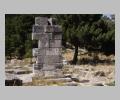| Context: | Priene |
| Type: | Propylon |
| Summary: | Monumental entrance to the Athena Sanctuary, oriented east-west; not aligned with central axis of temple. |
| Date: | ca. 25 BC - ca. 1 AD |
| Dimensions: | Width from exterior wall to exterior wall: 7.60 m.; projection of flight of steps beyond east of propylon: ca. 5.00 m.; length of propylon courtyard: 7.30 m.; preserved height of south wall (in 19th century): ca. 4.50 m. |
| Region: | Ionia |
| Period: | Roman |
Architectural Order:
Ionic; four columns at both east and west facades of propylon. Fragments of dentilated frieze and gable also preserved.
Plan:
In the east, six steps lead from the street level to a courtyard articulated by tetrastyle porticoes at the front and rear; a transverse wall with central door crosses the west end of the propylon.
Date Description:
Inscribed blocks from the second century B.C. reused in the foundations provide a terminus post quem. The use of lime mortar dates the monument to the Roman period; the renewed interest in the Sanctuary in the Augustan period suggests a probable date for the construction of the Propylon.
History:
The propylon belongs to a later date than the construction of the temple, probably to the period of Augustus, when interest in the Sanctuary was renewed with the rededication to Athena and Augustus. The structure was never completed - bosses remain on the columns of the west front and the paving was never smoothed.
Other Notes:
The propylon is not aligned with the central axis of the Temple but instead is situated slightly to the south, providing a visitor to the Sanctuary with a view of the south-east corner of the Altar and the Temple.
Pilaster capitals decorated with acanthus decoration, once believed to have articulated the interior walls of the propylon, are now thought to have come from at least four free-standing pilaster monuments, which once supported bronze statues, and which stood between the south wall of the temple and the south stoa. One of the Ionic column capitals (now in the British Museum) preserves the compass marks used in designing the volute.
Other Bibliography:

